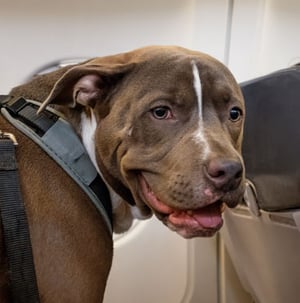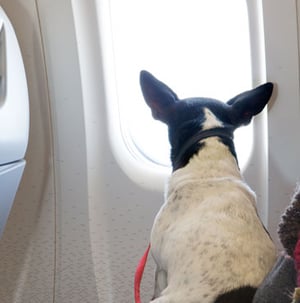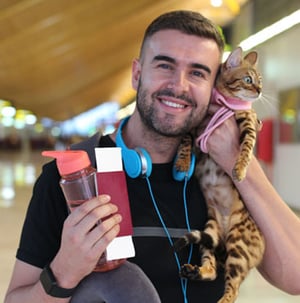How to Choose an Airline for Pet Travel
Updated on: September 18, 2024 | Author: Starwood Pet Travel

Pet travel, whether by air or car, has surged significantly in recent years. Dogs, cats, and other animals are cherished family members, so naturally, we want them to join us on our journeys.
However, leisure travel is one thing. If you’re planning a move, whether across the country or halfway around the world, you’ll definitely want your furry family member to come along, if possible. This will require substantial planning, but your beloved pet is worth it. One major decision you’ll need to make is which airline to choose for your pet’s trip.
Airline pet policies vary from one carrier to another, and navigating the maze of details can be challenging. We’ve created this guide to help you understand the information you’ll need to choose an airline and arrange air travel for your pet.
Questions To Ask
Not only does each airline have slightly different rules, but there is also no standard format for communicating these policies. This makes it even more crucial to know the right questions to ask, as the information you need may not be immediately obvious.
Which flight routes accept pets?
Not all airlines or aircrafts that accept human passengers can accommodate pets. It's important to check which flight routes can accommodate pets and understand that there may be limited options depending on your pet's breed, size, and destination. It's also possible that in order to have more flight options, you may need to travel to a farther airport that can accommodate your pet.
Can I do it myself?
Booking your pet's flight yourself is possible in some cases, but there are limitations. Some airlines and destinations will not allow pets in-cabin or as accompanied baggage, so they must be booked as cargo. Some airlines (such as Qantas and British Airways) may require the use of a professional pet shipper and will not accept pet reservations from pet owners.
If your pet is allowed in-cabin or as accompanied baggage on your own ticket, then you can reserve their space through the passenger side of the airline. However, if they must fly as cargo, then you'll need to make their reservation through the cargo side of the airline. The booking process and requirements for cargo differs from the passenger side and the check-in location will also be a different area of the airport.
What animals are allowed?
Airlines have become more strict on the types of animals that are permitted in cabin on the aircraft. In general, only small cats or dogs or legitimate service animals are allowed in-cabin on passenger flights. Larger dogs or other species typically need to travel as cargo. Many airlines no longer consider emotional support animals in the same category as service dogs, so they are just considered pets that may need to travel as cargo.
Airlines also have certain breed restrictions which may also vary by destination. Brachycephalic or snub-nosed breeds like Pugs and Bulldogs, are more risky to transport, so there are often airline embargoes for their safety.
Some airlines or destinations also have limits on breeds they consider dangerous or strong jawed, which may require special reinforced travel kennels or will not permit their travel at all.
It's very important to be honest and educated about your pet's breed in order to avoid any issues in booking their travels.
Where can my pet ride?

Possible options include in-cabin (under the seat in front of you), as checked baggage, or as cargo. Some airlines permit all three under certain conditions, while others may only allow one option. Be sure to check for destination exclusions or other specific rules.
Can pets travel to all of the airline’s destinations? Look for restrictions within the cabin—such as pets not being allowed in business class—as well as limitations related to certain aircraft, flights, or times of the year.
There are also uncontrollable factors that could impact your pet’s travel plans. One of the most common is weather embargoes. All airlines suspend pet travel when temperatures are too hot or too cold, and as we know, weather can be unpredictable. Inquire about this, as the specifics can vary between carriers.
What if there is a layover?
If your pet is travelin in-cabin with you, then you will be responsible for their transfer from one flight to the next. If they are flying as accompanied baggage, then the airport staff would transport them to the next flight for you. The same is true for pets traveling as cargo.
If your pet is traveling as accompanied baggage or cargo, it's best to select a trusted airline with experienced pet handlers at any layovers to ensure proper care of pets. For example, KLM has an onsite pet hotel in Amsterdam and Lufthansa has one in Frankfurt. These airports have facilities specially designed for animals of varying species to transit safely.
You'll also want to consider the length of time between flights and if there is a codeshare where the airline will change. If there is a very short layover, then your pet will not be given a comfort stop and they will simply be transferred by airport staff from one plane to the next. If you have enough time between flights at an airport with an onsite pet facility, then your pet can be given a proper comfort stop with access to food, water, and potty breaks prior to the next flight.
How do I book my pet?
The process for booking pets can vary by airline, so you will need to confirm that information with them. Some will allow you to make an online reservation while others require you to call them to confirm the details. You will also need to confirm the correct paperwork required as well as the location and timing for check-in to ensure you do not run into any last minute issues at the airport.
What documents are required?
Every country sets their own pet import rules, so they will have their own list of health and document requirements. Airlines may also have their own additional paperwork requirements on top of what the destination requires, so it's important to make sure you know exactly what is needed. We have a list of common requirements in this blog post.
If you’re bringing your pet from the USA to another country, you can review the pet import requirements on the USDA APHIS Pet Travel website.
What are their requirements for travel kennels?
Airlines generally don’t provide travel crates, but every pet who flies must ride in an IATA-compliant travel kennel.
If your pet can travel in-cabin with you, you'll need to confirm with the airline what their size requirements are since this can vary. In general they will need a soft or hard-sided carrier that fits under the seat in front of you.
Pets traveling as accompanied baggage or cargo required a hard plastic, wooden, or metal travel kennel that is large enough for them to stand up, sit down, lie down, and spin around comfortably. It's extremely important that your pet travels in the correct size kennel or they may be refused for travel at the airport.
How much will it cost?
Many airlines list their prices for in-cabin or excess baggage on their website. This typically starts at $150 USD per kennel and can vary by airline and destination.
If your pet is traveling as cargo then this is usually more expensive because the air cargo charges are based on the size of the kennel and weight of the kennel and the pet. This means that a 100 pound dog will be much more expensive to transport than a 10 pound cat. Once your pet's details are provided to the airline, they can confirm what it will cost for your pet to fly as cargo. Do keep in mind that if the actual size and weight of the kennel is different upon arrival to the airport, then you may have to pay more fees.
Helpful Hints About Pet Travel
In recent years, airlines have realized that while pets may travel in the cargo hold, their owners do not see them as mere "cargo." Pets are cherished family members, and pet parents naturally worry about the travel experience their beloved companions will have. Consequently, beyond the necessary information for booking an itinerary for your pet, many airlines now offer tips to make the process smoother.
Check Reviews
Each airline is eager to earn your business. Ultimately, your decision will hinge on your trust and confidence that they will treat your pet as a cherished family member. Fortunately, the internet and social media allow you to verify their claims to some degree.
Contact The Airline
You’re likely to have additional questions and want to know who to contact to get those answers. Check the airline's website for prominent contact information and consider these additional questions: Do they have a specialized team of agents for pet travel? What are the hours of availability for these agents?
Always Confirm the Details
Even if the airline pet policies seem straightforward on their website, we advise you to always contact them directly to confirm. This ensures you won't find out later that you've misunderstood something or made an innocent but incorrect assumption.
Each family's move is unique, considering factors like destination, time of year, and the type of pet(s) involved. Additionally, airline pet policies can change based on current conditions.
This is why it's crucial to work with a professional like Starwood who stays updated on all the details. Even if the airline you choose doesn't require a professional pet transport company, it's the best way to ensure that no detail is missed and that your pet's journey goes smoothly.
Photo by Seth Doyle on Unsplash
Subscribe to the Blog
Enjoy our content? Get them sent to your inbox!
Subscribe Now!



